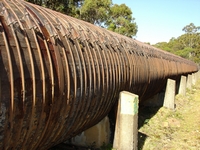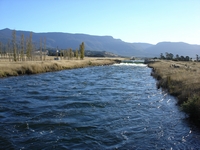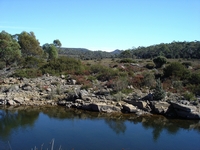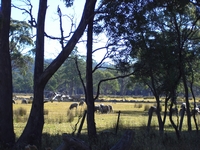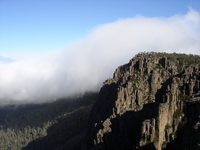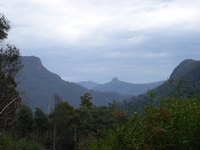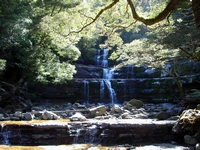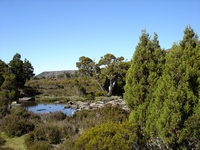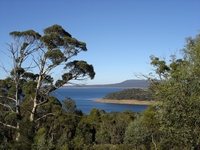Australia So Much to See


The Central Highlands – through the Mountainous Centre
Crossing the mountains: This includes parts of our west to east earlier
trip from Queenstown and south to north on the final leg of our Tasmanian tour. We also took a drive up in the mountain lakes
from the Eastern side. Many lakes have been dams to increase water supply for the series of hydro-electric power stations. The water continues on to the next power station after each use.
We drove from Queenstown eastward through the northernmost
section of the Franklin-Gordon Wild Rivers National Park to Lake St Clair, where we were repelled by a huge tourist complex, full
car park and crowds of people. We followed a back road to a lovely little lagoon amongst salmon barked trees.
Early
morning from our camp on the edge of a small lagoon (dam) that provides water for the extensive hydro-electricity networked system.
The
water from the dam ran through an old timber pipeline, constructed of board held together with bands of metal rods, a construction
known as wooden stave.

The
Tarraleah
power station is one of a vast network of power stations in central
Echidnas are sometimes seen crossing the road. They usually curl up into a ball if approached. Their
quills can pierce a tyre if they are run over.
Despite a huge number of shacks and holiday houses surrounding The Great Lake,
it is a huge and very scenic lake high in the mountains. Like most lakes, the overflow has been raised with a dam wall to store
water for the hydro electricity schemes.
The board walk at
As
we descended towards Deloraine, we found
The drive up to Arthur’s Lake and the
In
1957 a decision was made to stop water flowing south from the
From here the water flows down a large, high-pressure steel penstock and vertical shaft into
The Poatina Power Station is a huge underground excavation, as wide as a city street,
as long as a city block and as high as a seven storey building. It houses six, fifty megawatt generators and is the State's second
largest power station.
Close up of the canal which carries water rushing from the power station. In the picture from above,
the canal can be seen.
The water then goes into the Lake Trevallyn Dam, from where it flows via a tunnel into the Trevallyn Power
station at Launceston.
At the start of the ‘penstock’ there is a service adit, with a large flat area overlooking vistas
to the east. You can hear the water roaring from within in the hill. We did not have the caravan that day, or we would
have stayed at this ideal spot.
Near
Looking into the Walls of Jerusalem Park from the northern end. This is only accessible on foot. We drove around forestry
tracks in the area bounded by this park and the Lake St Clair –
Fisher River Lookout,
with the highest peaks such as Mount Ossa 1740 metres, Barn Bluff 1690 metres, and
We returned later in the morning to see the
When we reached nearby Devil’s Gullet, we could
see under the cloud which was like a finger reaching across the valley. Then we heard an eerie hissing sound and felt the cold
wind, as we saw the finger rise up and engulf the bluff on the left side of the valley. The cloud came roaring towards us around
the bluff just to the left of the lookout, until we were and the entire valley were engulfed in the clouds. This was an awesome
experience, with us wanting to run and escape the cloud about to engulf us, yet we remained, fascinated by this phenomena.
Tasmanian
walk trails are well made, and seating is usually offered along longer walks. This one was near Mole Creek.
Sunset across
the Western Tiers from the Mole Creek campsite.
We drove through the upper Mersey valley then looked back through the valley
to the mountains, including the major peaks of the
Further along Oliver’s
Road, we came to the Round Mountain Lookout, with views to the north. Just right of centre is a pipeline (penstock) heading
down the mountain, to the Cethana power station, where we had been some weeks earlier. Here we saw the penstock at close range,
from the top of the Lake Cethana Dam, a dam like so many used for power and recreation. Water has come through a tunnel from
the Wilmot dam.
This concludes our journey through
